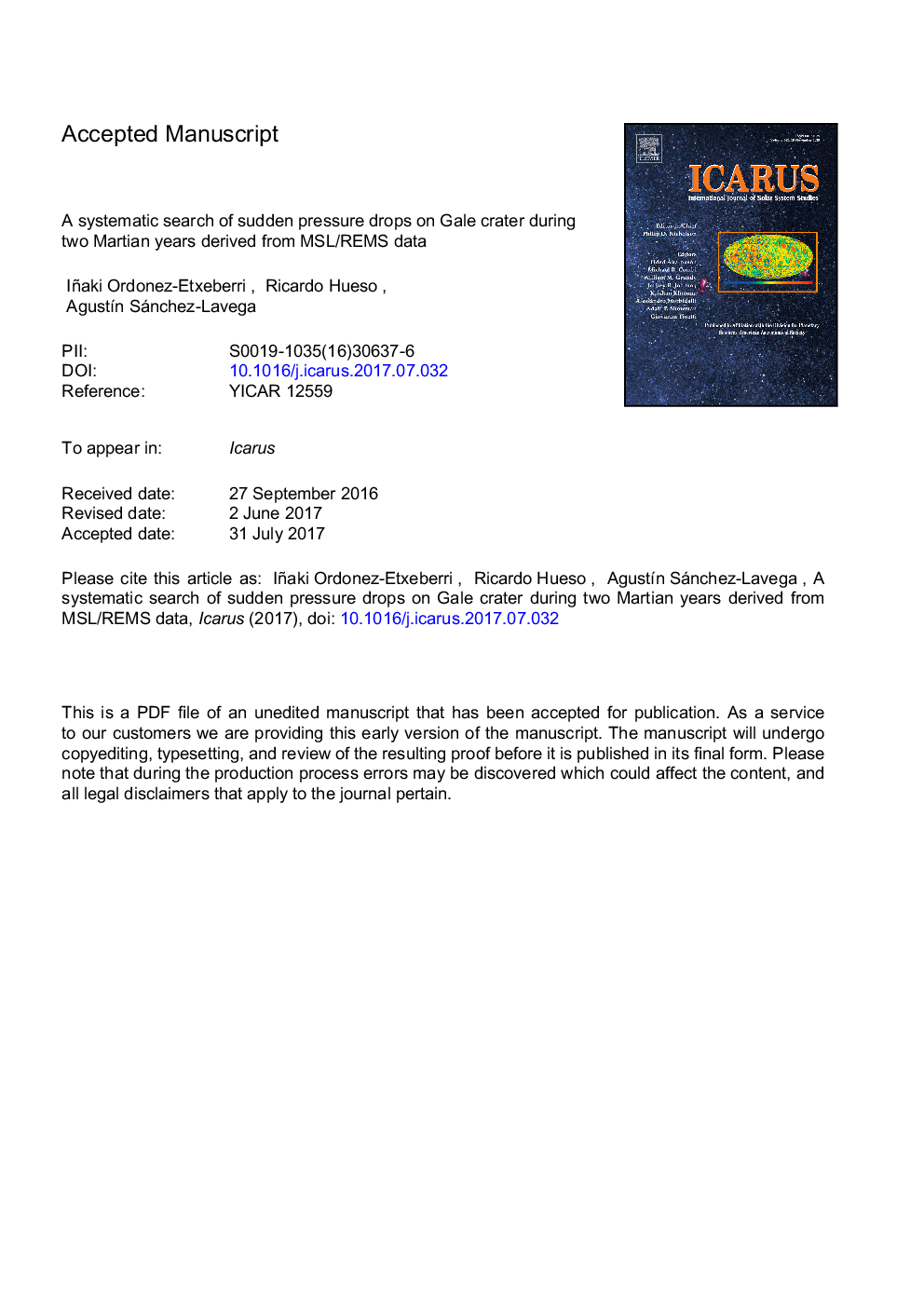| Article ID | Journal | Published Year | Pages | File Type |
|---|---|---|---|---|
| 5487232 | Icarus | 2018 | 63 Pages |
Abstract
The Mars Science Laboratory (MSL) rover carries a suite of meteorological detectors that constitute the Rover Environmental Monitoring Station (REMS) instrument. REMS investigates the meteorological conditions at Gale crater by obtaining high-frequency data of pressure, air and ground temperature, relative humidity, UV flux at the surface and wind intensity and direction with some limitations in the wind data. We have run a search of atmospheric pressure drops of short duration (< 25â¯s) and we present a statistical study of the frequency of these events in the REMS pressure data during its first 1417 sols (more than two Martian years). The identified daytime pressure drops could be caused by the close passages of warm vortices and dust devils. Previous systematic searches of warm vortices from REMS pressure data (Kahanpää et al., 2016; Steakley and Murphy, 2016) cover about one Martian year. We show that sudden pressure drops are twice more abundant in the second Martian year [sols 671-1339] than in the first one analyzed in previous works. The higher number of detections could be linked to a combination of different topography, higher altitudes (120â¯m above the landing site) and true inter-annual meteorological variability. We found 1129 events with a pressure drop larger than 0.5â¯Pa. Of these, 635 occurred during the local daytime (â¼56%) and 494 were nocturnal. The most intense pressure drop (4.2â¯Pa) occurred at daytime on sol 1417 (areocentric solar longitude Ls = 195°) and was accompanied by a simultaneous decrease in the UV signal of 7.1%, pointing to a true dust devil. We also discuss similar but less intense simultaneous pressure and UV radiation drops that constitute 0.7% of all daytime events. Most of the intense daytime pressure drops with variations larger than 1.0â¯Pa occur when the difference between air and ground temperature is larger than 15â¯K. Statistically, the frequency of daytime pressure drops peaks close to noon (12:00-13:00 Local True Solar Time or LTST) with more events in spring and summer (Ls from 180° toâ¯360°). The nocturnal sudden pressure drops concentrate in the 20:00-23:00 LTST time interval and they only occur in spring and summer. We interpret these nocturnal events as a consequence of local mechanically forced turbulence. This interpretation is consistent with published results from simulations with the MRAMS model (Rafkin et al., 2016) that predict a competition between local orographic circulation and global Hadley cell circulation at Gale crater at summer night-time that can enhance forced turbulence at the surface. Bursts of pressure drops appear on particular sols, especially at night-time. Most of the vortex bursts occurred when MSL was in the region called Pahrump Hills characterized by a complex terrain. A comparison of the daytime pressure drops from REMS data with published results from the Pathfinder and Phoenix missions shows that the frequency of daytime events at Gale crater in spring and summer is similar to the one previously found at other locations. Finally, we present possible correlations between MSL activity and some daytime pressure drops. If such an instrumental effect is present in the REMS data its impact in this analysis is small and would only affect about 7% of our detections.
Related Topics
Physical Sciences and Engineering
Earth and Planetary Sciences
Space and Planetary Science
Authors
Iñaki Ordonez-Etxeberria, Ricardo Hueso, AgustÃn Sánchez-Lavega,
